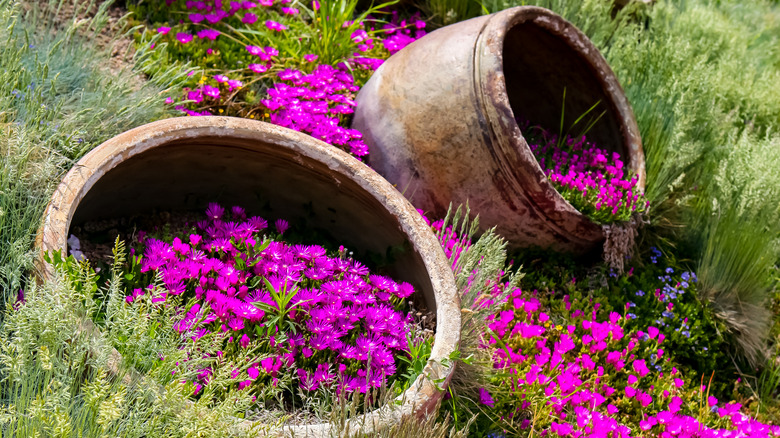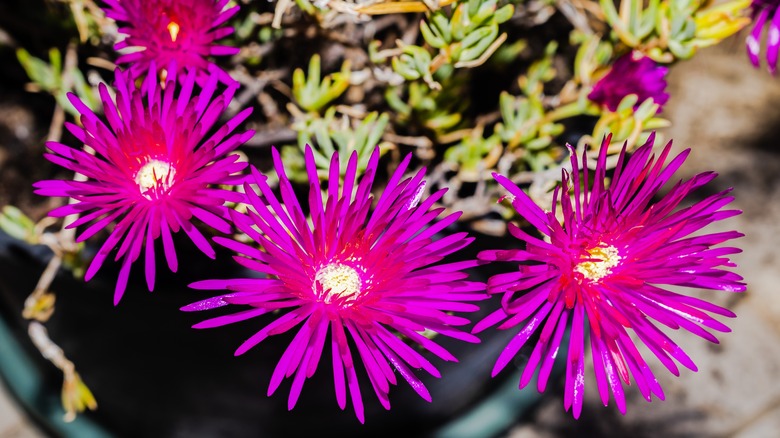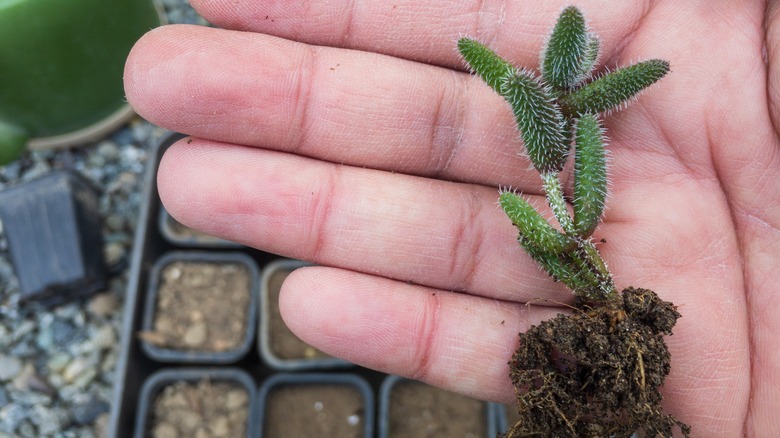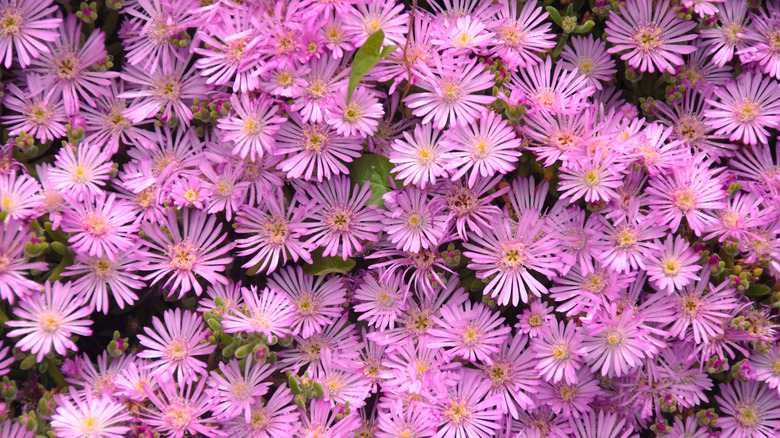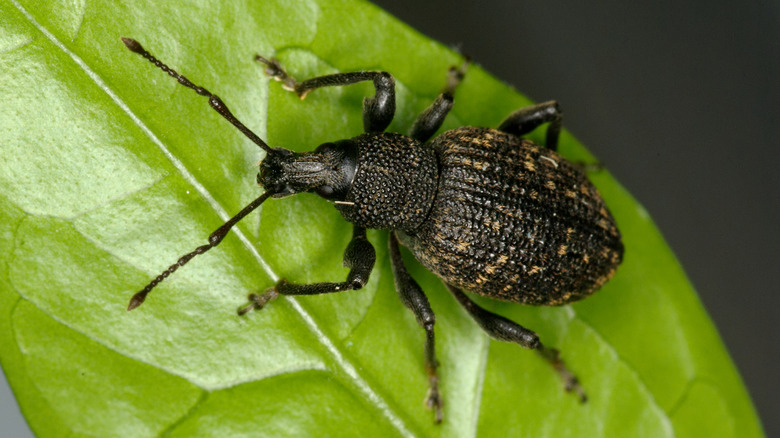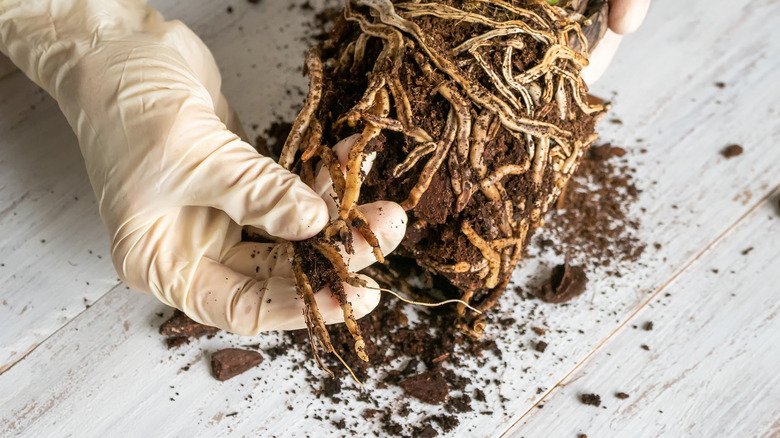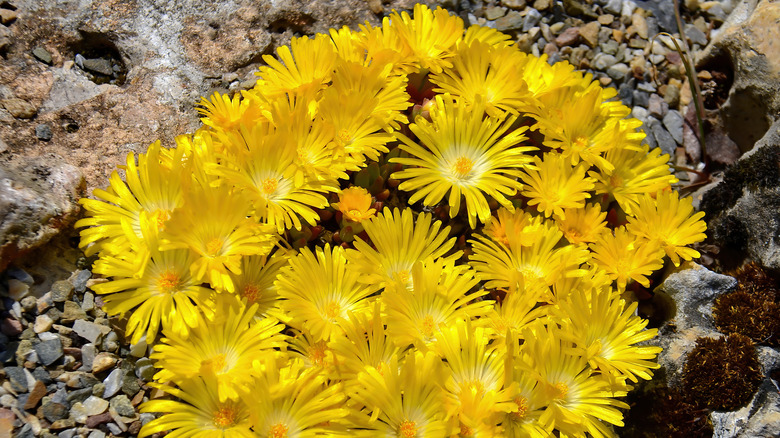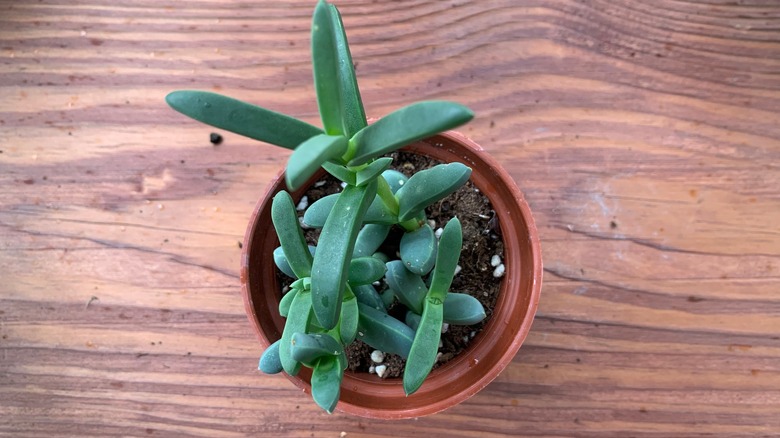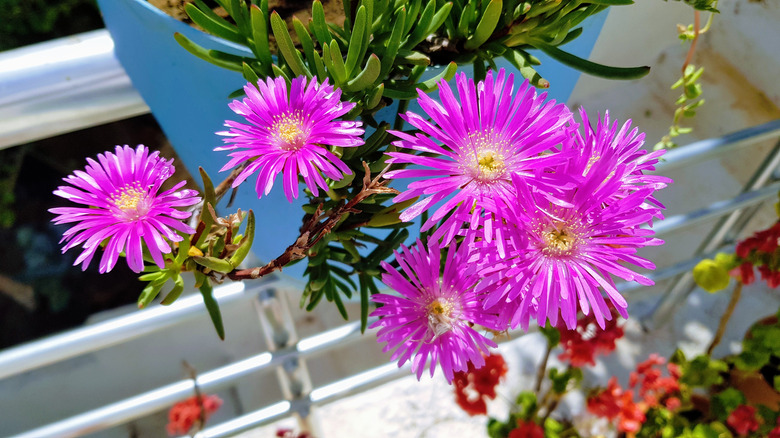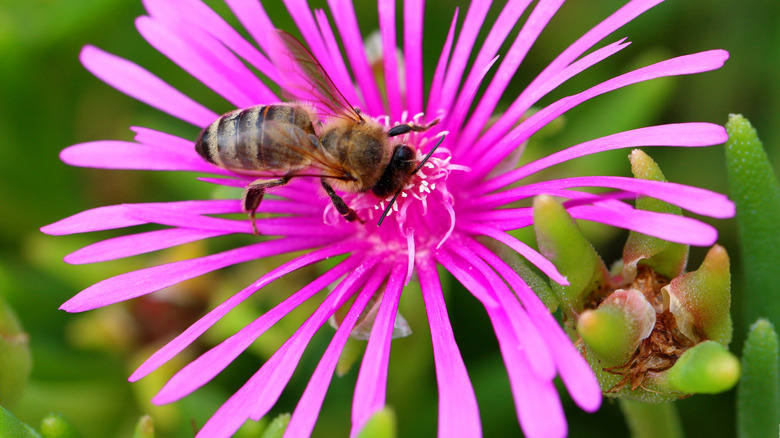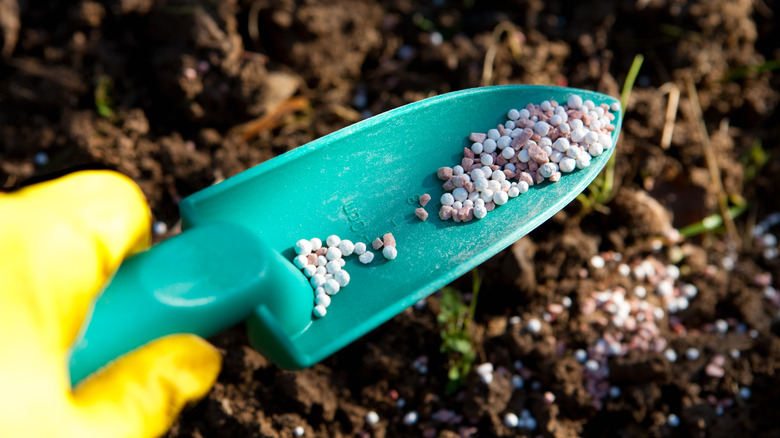Ice Plant: Everything You Should Know Before Planting
The gorgeous ground cover succulent known as an ice plant, Delosperma cooperi, is drought resistant and non-invasive. It can handle mild winters with a little extra care, but that is not how it gets its name. The stems boast tiny light-reflecting hairs, which look like shimmering ice crystals when the sunlight hits them, says A to Z Flowers. The ice plant has a long bloom season that runs from spring into fall. It features pretty flowers that are similar in shape to daisies but have bright pinkish-purple petals with a yellow center.
Since ice plants are from the genus Delosperma, which is Greek for "visible seed," you will find exposed seeds at the bottom of the bloom that can be collected after the flower wilts and dries. The ice plant stems and leaves grow into a lush mat-like ground cover that will stretch four inches to several feet, making a nice spread over gritty soil or cascading down a pot, according to Hartley Botanic. Despite their name, ice plants are hardy and can survive under hot, unfriendly conditions. In addition, pollinators love them! They offer a terrific landing pad that butterflies find handy and colors that bees are attracted to, like purple and yellow. Keep reading for tips on how to use the ice plant to fill any dry spots in your garden.
How to use ice plants in a garden
Like most succulents, the ice plant is drought resistant, with shallow roots. Succulents — from the Latin sucus, meaning juice — hold water in their stems and leaves, so they thrive in quick-draining soil. With that in mind, ice plants are a great solution for problematic garden spots that get so much sun that the topsoil is often dry to the touch, making it a tough area to cultivate anything green or lush. Ice plants can be planted next to other succulents or plants that have similar well-draining soil needs. They also like direct sun for up to eight hours a day, says Costa Farms. Give your ice plants less exposure than that and they will penalize you with fewer blooms.
Since the ice plant is a ground cover, it grows only a few inches tall, per Plant Care Today, so consider tucking them next to taller drought resistant plants in order to mix heights and add balance to the overall layout. You can use ice plants to spruce up steeper slopes within your garden or as a border around the outer parts, since they also offer the added bonus of being deer resistant. To maintain your ice plant's healthy size and shape without it growing overtop itself, prune wilted or dead stems after winter so your ice plant starts fresh in the spring.
How to propagate and grow your ice plant
Ice plants are best grown from starter plants that you can find at most nurseries. Another easy option is to take cuttings from a neighbor or friend willing to share, since they sprout roots and propagate quickly, according to Hunker. Cut your ice plant clipping in the spring by first choosing a stem without a blossom. With clean garden shears, make the cut as close to the base as you can get. Plant your clipping in a cup with well-draining soil, making sure the cup has drainage holes, and set it in area with bright, indirect light. Water only occasionally so the soil stays relatively dry until you notice the roots take hold.
Once you are ready to plant your cutting, start with a sunny spot in your garden, says High Country Gardens. If your soil is rich and dense, try adding perlite, sand, or natural mulch to the topsoil to loosen it. This will help keep it from retaining too much water. Damp soil that stays wet for too long will cause root rot in most succulents, and the ice plant is no exception. Plant your cuttings by mid-summer unless you live in a particularly hot climate, in which case a fall planting works best. Separate each new plant by 15 inches or so to give them room to spread as they grow.
How to care for your ice plant
Ice plants need minimal water during the summer but even less as the winter approaches, says High Country Gardens. Succulents retaining too much moisture as they head into winter dormancy season are not likely to survive the cold months, so it's important to let their leaves and stems dry out before the first frost. Dormant ice plants can tolerate cold winters, but if your area experiences constant snow, you may want to consider a frost blanket to keep them dry.
Other than that, ice plants are particularly easy to care for, says Kellogg Garden. Just remember to position them so they get a good eight hours of direct sun in easy-drain soil conditions. You can water your ice plants as little as a few times a month, depending on rainfall in your area. You might consider adding extra mulch to help them as they overwinter.
Common ice plant pests and how to get rid of them
In the pest category, you may find the common offenders: aphids, mealy bugs, slugs, spider mites, and scale, all of which can usually be managed with a sharp spritz from the garden hose and some insecticidal soap. A less commonly seen pest that affects ice plants is called the vine weevil. Shown in the image above, these buggers are 1/2-inch long black insects with mottled mustard yellow spots on their thorax and abdomen. Adult vine weevils are night feeders, so your best bet for tracking them down is to head out to your plants after the sun goes down and pick them off the leaves by hand. However, it's more important to control the larvae that cause considerably more damage. Approved pesticides include Orthene, Bio-Neem, and Thiodan.
As for diseases, ice plants often battle sooty mold and fungi such as botrytis, fusarium wilt, or verticillium wilt. Fungal diseases can lead to the death of a plant, but sooty mold is nothing more than a superficial discoloration that will go away once aphid and scale populations are under control. If you're dealing with fungi, consult a professional to determine the best approach depending on specific factors that will determine which type is present and which fungicide is most likely to help.
Root and crown rot with ice plants
Root and crown rot are unfortunate and detrimental conditions that occur all too easily with Delosperma. Ice plants look so different from the cacti, jade, and echeveria we're used to seeing that it's easy to forget they are succulents too. Waterlogged soil is a direct path to mushy, rotting roots for all succulents, so it's very important to be intentional with your watering schedule. Use a moisture meter and stay attuned to weather conditions, especially unusually long rainy spells.
Even though it happens below the soil, you'll be clued into the presence of root rot when you see a stunted or wilting plant that is losing leaves and has a weakened stem. You may simply have soil that is too dense and needs better aeration and drainage from conditioners like perlite and vermiculite, but a severe case of root rot is rarely reversible. You can try cutting away damaged roots, cleaning the original pot, rinsing the healthy roots, and replanting with fresh potting mix, but know in advance that this is not guaranteed to work.
Ice plant varieties
The ice plant originates from South Africa, and is part of the Alzoaceae family, according to The Succulent Eclectic. In addition to the Delosperma cooperi, the Delosperma genus features several varieties that are still ground cover, but present varying shapes of leaves and flower colors. Here are a few:
- Delosperma congestum (pictured above) is commonly referred to as a golden nugget. It also looks similar to daisies and is in fact a yellow bloom.
- Delosperma ashtonni 'Blut' also keeps the daisy-like appearance but with a crisp white cap in the middle of its vibrant deep purple-pink bloom.
- Delosperma echinatum diverges quite a bit from the daisy look, in that its stems and leaves are covered in soft looking fuzz along with much smaller blooms which are usually yellow.
- Delosperma nubiginum was once sold under the Delosperma congestum moniker. It is now commonly called the hardy yellow ice plant, even though its leaves fade to reddish tints in winter, says High Country Gardens.
- Delosperma floribundum, or starburst, delivers vibrant pink flowers with a white cap center on its blooms, according to Gardening Know How.
Is the ice plant toxic?
Ice plants are generally nontoxic to pets, and the Delosperma cooperi is a particularly safe variety, says eHow. In fact, ice plants are edible for humans. Salt Magazine suggests the salty crunch of the ice plant's juicy stems and leaves make it a terrific multipurpose ingredient.
The ice plant is great for stir-fries, fresh salads, and even steeped for tea. It is low calorie thanks to its high water content, and it's rich in vitamins A, B, and C. Some other nonessential nutrients contained in the plant have health benefits known to undermine menopause flare-ups and may protect against breast cancer. As if that were not enough, the sap in its leaves have trace antibacterial elements that can be used as a topical antiseptic, says Specialty Produce. It can also be used to soothe irritated, itchy, or inflamed skin by adding it to your bathwater for a good soak.
How to repot your ice plant
Ice plant roots are shallow and not prone to tangle, so it can thrive for years in the same pot as long as you offer your plant enough sunlight and the appropriate amount of water in fast-drying soil, says UK Houseplants. Every three years or so is a good rule of thumb to consider repotting, or if you want to divide your plant, the process is easy.
Repotting is best handled in the spring, after your ice plant's dormancy season is coming to a close. Succulent roots tend to be rather delicate, so prep your ice plant with a nice soak the day before repotting to help minimize root shock. Remembering that long-standing moisture is the enemy of a flourishing ice plant, have your new pot ready with proper drainage holes and a succulent-friendly, fast-drying potting mix.
Gently pull up your ice plant and cut between the main plant and a section of stems and roots that has sprouted from it, says National Gardening Association. Try to keep the soil intact around the roots of your divided plant and then place it gently in soil enriched with perlite and sand. Give it some water and move your newly repotted ice plant to a bright spot with plenty of indirect sunlight until the roots take hold in their new pot. Unlike starting from a cutting, you will want to let the soil completely dry before re-watering.
Ice plants attract bees and keep the deer away
Many gardeners are aware of how important it is to make our gardens pollinator-friendly, but that only goes so far if we neglect to also add deer- and rabbit-resistant plants. Upwards of 80% of plants around the world depend on pollination for their survival, and many of these very plants grow into the crops that feed the world's population. By adding plants that are both pollinator-friendly as well as deer- and rabbit- resistant to our gardens, we can increase all of our plants' chances to thrive.
The ice plant is a perfect combination of both, says Why Farm It. Their list of best varieties includes the Cooper's ice plant, which gives reddish-purple blooms, and the moonstone ice plant, which gives you a white bloom and yellow-cap center. They are beautiful and, despite their non-toxicity to pets in general, deer generally do not like leaves with fuzz and tend to steer clear of their thick succulent stems. Rabbits also find ice plant stems and leaf textures unappealing. Unfortunately, squirrels do still like ice plants for their bloom petals.
What to do if your ice plants aren't flowering
Ice plants are appreciated for their long-lasting bloom cycles. Under the right conditions, your patch of Delosperma should start flowering in the spring and keep going well into fall. So, if you have an ice plant that has stopped blooming mid-season but otherwise seems healthy, you know there's an underlying problem that will require a little detective work. More often than not, the issue stems from environmental issues or a nutritional imbalance. Lack of direct sunlight is a common environmental culprit, as are improper watering and pests. These seem simple enough to correct, but consider that if it's been particularly rainy or even just cloudy in your area for an extended period of time, you may have to succumb to the sad truth that your ice plants won't be blossoming as much as usual.
When considering nutrition from fertilizer, take the nitrogen-phosphorous-potassium (NPK) ratio into consideration. Standard 10-10-10 formulations have equal amounts of each of those macronutrients, but when you're addressing very specific problems (lack of blooms), you need to get more specific with that ratio because you need less of one and more of another. Nitrogen is the nutrient that ensures healthy, lush foliage; too much of it can inhibit flowering. Look for a fertilizer with a ratio closer to 10-30-20, which means it contains a higher concentration of phosphorous and potassium instead.
